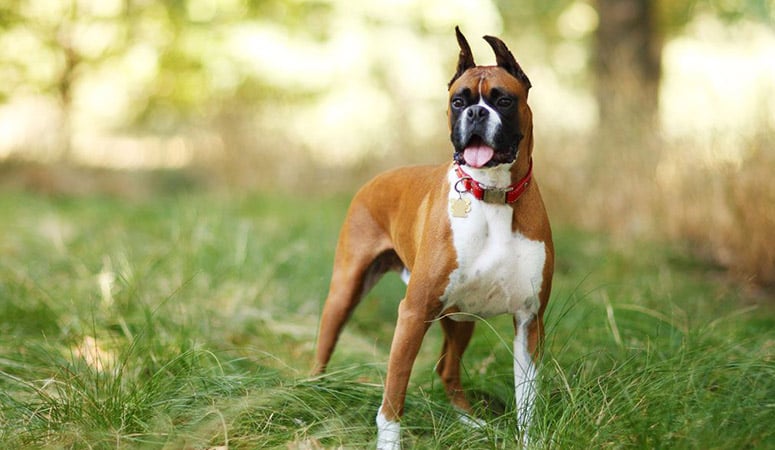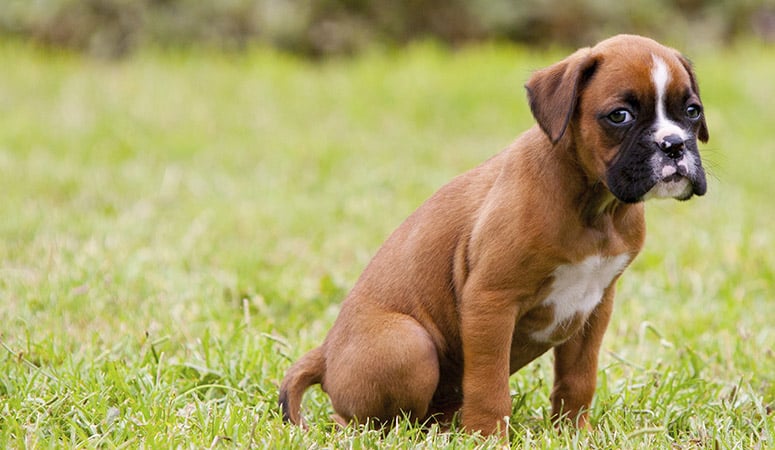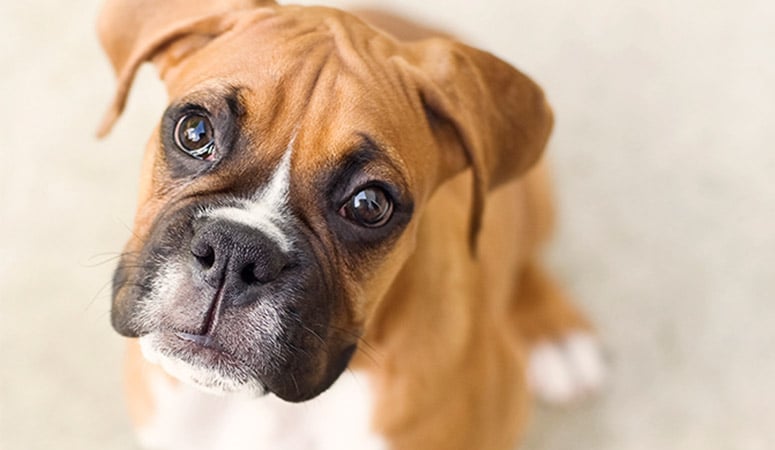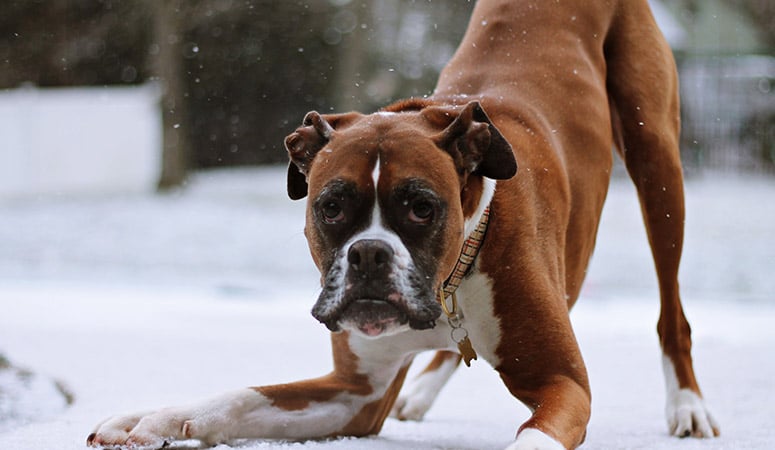Boxer
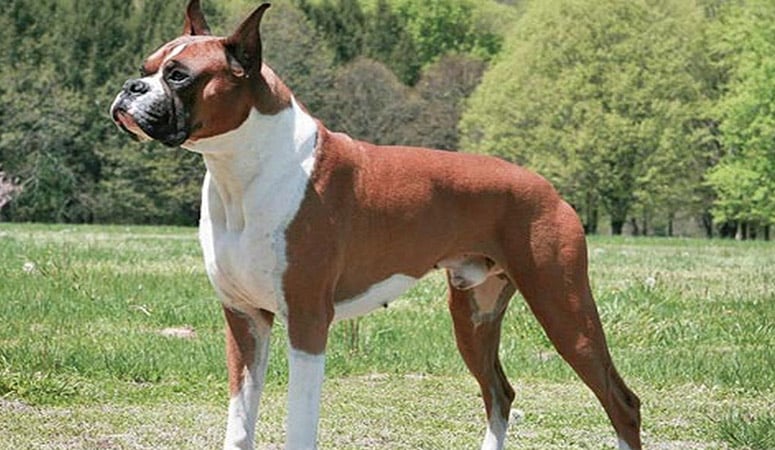
Strong, energetic, and with a muscular build, the Boxer is a dog who combines stylish elegance, strength, and agility. His head is distinctive, with a broad, blunt muzzle and alert expression, and this breed can suit to serve as a guard dog, as well as a great family companion.
| Other Names | Deutscher Boxer, German Boxer |
| Color | Brindle, Fawn, White |
| Height | Males: 22-25 inches. Females: 21-24 inches. |
| Weight | Males: 66-70 pounds. Females: 55-62 pounds. |
| Life Span | 10-12 years |
| Personality | Bright, Fun-Loving, Active |
| Exercise | Energetic |
| Origin |
| Popularity | #14 |
| Groom Needs | Weekly |
| Kids Friendly | Yes |
| Dog Friendly | Yes with supervision |
| Watch Dog | Yes |
| Family Dog | Yes |
| Litter Size | 6-8 |
Boxer Pictures
Boxer Video
Introduction
If you’re looking for an active, playful dog capable of pulling silly pranks once in a while and yet bold and fearless, you may not have encountered a Boxer. They go with a close-fitting coat of short, smooth hair. The coat is usually marked with white, with wider coverage of fawn or brindle in the main. They are a unique breed of work-dogs bred from older generations of bulldogs.
With powerful jaws, a square muzzle, and an underbite, the standard Boxer appears vicious and intent. Boxers have a heavy build to match up with their features. A well-fed male would likely weigh somewhere around 70 or 75 pounds, reaching a height of 22-25 inches at the shoulder, while a female breed runs smaller by a few points.
A Boxer can be as cool as a cucumber, fun-loving, and all when it’s at ease with you. On the flip side, the same Boxer can be a terrible nightmare when it smells mischief in the air. Therefore, Boxers qualify as watchdogs and guard dogs. Also, their protective instincts have endeared them as a dandy children companion. It’s preferable that Boxers, as puppies, are exposed to a lot of people, animals, and the outside world. Boxers grow really old to an average of about 12 years of age before they eventually die.
Living with Boxer
The Boxer’s short, shiny coat requires very little grooming. Brushing your Boxer’s a few times a week can keep his coat shiny and healthy, also, a regular brushing could help minimize the hair in the house. Also, you can enhance the natural sheen of your dog’s coat by rubbing it down every now and then with a chamois cloth. The Boxer tends to be a clean dog, bath only as needed.
Besides, the owner needs to brush your dog’s teeth at least two or three times a week to help remove tartar and bacteria, and the daily brush is better to keep fresh breath and prevent gum disease. And gently clean your Boxer’s ears with a soft cleanser or solution recommended by your veterinarian. Trim their nails at least once a month if they don’t wear down naturally.
Boxer is a very playful and high-energetic dog, but his nose and short coat lead him unsuited to living outdoors. The owner can play with your dog or walk with him at least twice a day for half an hour to keep his muscles toned and satisfy the need for exercise. Besides, taking your dog to participate in dog sports is a good idea, such as running, agility training, and flyball. Giving your Boxer plenty of daily exercise is the best way to ensure good behavior.
As the Boxer is an active, powerful, and playful dog, this breed is not very suitable for old people.
An ideal Boxer diet should be formulated for a medium-sized breed with high energy. The food amount should vary from their size, weight, age, activity level, so they may require anywhere from one and a half to six cups of high-quality dry dog food per day. There should be clean fresh water at all times.
Some dogs are easy to get overweight, so you need to watch their calorie consumption and weight level all the time. Treats may be an important aid in training, but excessive intake can lead to obesity. Also, owners need to distinguish which human food is safe for dogs and which are not. If you have any problems with your dog’s weight or diet, just consult from your veterinarian.
Boxers are prone to the following health conditions: hip dysplasia, Boxer cardiomyopathy, Subvalvular aortic stenosis (SAS), Gastric torsion, Colitis, Hypothyroidism, Corneal erosion, Deaf…
Major concerns: SAS, boxer cardiomyopathy, CHD
Minor concerns: gastric torsion, colitis, corneal erosion, hypothyroidism
Occasionally seen: degenerative myelopathy, brain tumors
Suggested tests:
Hip Evaluation
AS\SAS Cardio
ARVC DNA Test
Elbow Evaluation
Thyroid Evaluation
Degenerative Myelopathy DNA Test
Boxers are particularly predisposed to having adverse drug reactions to even small doses of Acepromazine and other phenothiazines.
Total Annual Cost: $3239
Cost is estimated for the first year and may vary depending on many factors, such as dog food, health care, leash, collar, licensing, possible fencing, crates, training and obedience classes, dog-walking, grooming, treats, toys, flea, tick, and heart-worm meds, microchips, etc.
Boxers are prone to be trained, with their exceptional intelligence and endless curiosity, but, they may become bored with repetition. It is a good idea to use rewards when training as they are effective in this process.
The owner should start early socialization and training from puppyhood, which is very important to channel the breed’s energy and exuberance in a positive way. Because Boxers are always in motion, sometimes training can be difficult. They should be trained with consistency and patience like other large dog breeds, they don’t response well to harsh treatment.
Besides, Boxers excel in a wide range of canine sports, such as obedience, agility, and herding, also, they could become working dogs to participate in search and rescue activity or as service, assistance, and therapy dog.
History
German in origin, the Boxer belongs to the Molosser dog group — a group consisting of Mastiffs and Bulldogs which are believed to have descended from the ancient Molossus breed of historic Assyria. The history of modern-day Boxer dogs can be traced back to the 19th century. The Boxer has a close resemblance to Bulldogs and it is generally accepted that they were descendants of a cross between Bulldogs from Great Britain and Bullenbeissers of Mastiff descent.
The Bullenbeissers were hunting dogs that preyed on wild boars and deer. As time advanced, the demand for smaller and faster breeds grew and soon a smaller breed was developed in Belgium. This was the Brabanter Bullenbeisser from which Boxer dogs had most likely descended.
Deutscher Boxer Club, the first Boxer Club was founded in 1895 following deliberate efforts to improve the breed, which commenced in 1894. In 1896, the Boxer debuted in a show ring in Munich, Germany. However, it wasn’t until the beginning of the 20th Century that the Boxer dog was recognized in the U.S, the American Kennel Club (AKC) registering the first Boxer dog in 1904.
Helpful Information
Breed Club: AMERICAN BOXER CLUB
Breed Club Link: http://americanboxerclub.org/
Breed Club Rescue:
Breed Club Rescue Link: http://americanboxerclub.org/boxersitesrescue.html

